WAORANI
The Saga of Ecuador's Secret People:
A Historical Perspective
© Adrian Warren, Last
Refuge Ltd., March 2002, in association with Dr. James Yost
Exploration for oil,
which had by now been going on for almost forty years, had become a real
threat to Waorani lands. Through the sixties and seventies, many international
companies were becoming involved, working in increased safety since so
many Waorani had been persuaded to move off the land to the Protectorate.
Although Tagae's group continued to kill all who came near, he and the
other remaining isolationist Waorani groups were losing ground. The oil
companies would soon penetrate Waorani lands everywhere, cutting a criss-cross
network of trails every kilometre or so.
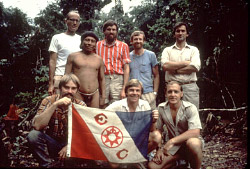 Waorani
Amazon Expedition 1983
Waorani
Amazon Expedition 1983 |
As outsiders continued
their relentless advance on to Waorani lands, Jim decided it was time
to document the traditional way of life of Caempaede's group on film
before it was too late. Fifty-year old Caempaede was still living
as his ancestors had for generations untold, although now in peace
rather than in war. His community still hunted with blowguns and spears,
planted gardens, relied heavily upon kin relationships for survival,
and held a thorough and deep understanding of their environment. |
Caempaede's group were still a people who were living
in perfect equilibrium with the forest, which in turn provided everything
they needed for their daily lives. But for how much longer this traditional
life would continue was difficult to predict.
Jim worked with a
team from the BBC in 1982 to film a short sequence on the Waorani
for David Attenborough's "Living Planet" series. Then, by
chance, Jim was contacted by Grant Behrman, a South African living
in the USA, who wanted to organise an expedition in 1983 to visit
the Waorani. It seemed a good opportunity to make a full length documentary
film, and the BBC again became involved. The American Museum of Natural
History in New York wanted to create an exhibit on the Waorani so
the task of making a collection of traditional artefacts was added
to the expedition's agenda. A medical study was also undertaken. It
became a huge project and Jim was concerned about the sociological
impact of a team of seven cowode with a mountain of equipment descending
on a small community of Waorani. |
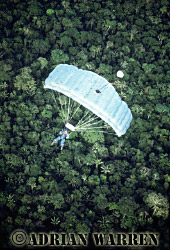 Grant Behrman, rio Cononaco,
Ecuador, 1983
Grant Behrman, rio Cononaco,
Ecuador, 1983 |
In order to maintain some control over the intrusion,
the expedition made an independent camp some distance away from Caempaede's
community on the banks of the river Cononaco. All the equipment and personnel
were ferried in by light aircraft from the Missionary Aviation Fellowship
based at Shell Mera to the oil company airstrip and then by inflatable rubber
boat to the camp site. Once established the team waited for the Waorani
to visit, hoping that it would not be a raiding party in the middle of the
night. No doubt the activities of the cowode were observed continuously
from behind a screen of forest foliage, but, on the third day, during the
afternoon, some Waorani appeared in full view on the opposite bank of the
river and stayed for some fifteen minutes, before disappearing into the
forest once more. The following day, a party of Waorani calmly walked into
the cowode camp and made themselves at home, lying in hammocks, examining
equipment and closely watching activities. For Jim, this was a critical
moment, but his presence signalled to the Waorani that they were among friends
and the meeting was calm and peaceful. The following day, the cowode paid
a reciprocal visit to one of the traditional houses where several families
lived. It was another peaceful encounter and now the work could begin. The
expedition team stayed with Caempaede's group for a month documenting their
daily lives, hunts, crafts, relationships and gardening activities. The
material was edited into three film productions: "Waorani - The Last
People" (BBC), "Nomads of the Rain Forest" (WGBH Nova), and
"Waorani" (ABC). Jim had mixed feelings about the project; on
the one hand, his primary motivation in making the film was to present the
issue of the need to protect Wao land from encroachment and loss, to try
to get the International community to recognize the tenuous situation the
Waorani were in; and he also knew that unless the documentary was made,
there would be no archival film record of Waorani traditional life. On the
other hand, however, he knew that many people would see the film and would
therefore want to visit the Waorani, with all the risks that uncontrolled
contact and diseases might bring.
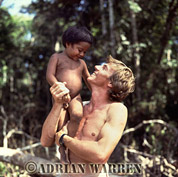
Adrian Warren |
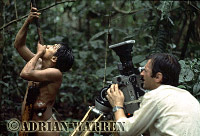
Hugh Maynard filming Karowae |
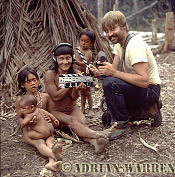
Minimo with Joel Rettig |
|
